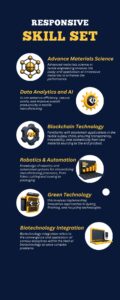Best 10 Tech Skills for Textile Engineers
The synergy between materials science, nanotechnology, and data-driven approaches has ushered in an era where textiles are not merely fabrics but sophisticated entities embedding intelligence, functionality, and adaptability.

Here are the Best 10 Tech skills for Textile Engineers
Advance Materials Science: Advanced materials science in textile engineering involves the study and application of innovative materials to enhance the performance, functionality, and sustainability of textiles. It combines principles from materials science, chemistry, nanotechnology, and engineering to develop new materials or modify existing ones for various textile applications.Best 10 Tech skills for Textile Engineers
- Smart Textile: Integration of electronic components and sensors into textiles to create smart fabrics capable of sensing, reacting, and adapting to environmental changes or user requirements. These textiles may include conductive fibers, flexible circuits, and embedded sensors for applications in healthcare, sports, fashion, and more.
- Nanoengineered Textiles: Utilizing nanotechnology to manipulate materials at the nanoscale, resulting in enhanced properties like increased strength, durability, water repellency, and stain resistance. Nanofibers, nanoparticle coatings, and nanostructured surfaces are some examples.
- Composite Materials: Integration of diverse materials to create composites that possess combined advantageous properties. For instance, combining textiles with polymers, metals, ceramics, or carbon fibers to produce lightweight yet strong and durable materials.Best 10 Tech skills for Textile Engineers
Data Analytics and AI: Proficiency in data analysis, machine learning, and artificial intelligence (AI) for predictive maintenance, quality control, supply chain optimization, and product development. AI can enhance efficiency, reduce waste, and improve overall productivity in textile manufacturing.Best 10 Tech skills for Textile Engineers
- Supply Chain optimization: Data analytics can be employed to optimize the textile supply chain by analyzing various parameters such as inventory levels, demand forecasting, supplier performance, and transportation logistics. AI algorithms can help in predicting demand patterns, reducing excess inventory, and optimizing production schedules to meet customer needs more effectively.Best 10 Tech skills for Textile Engineers
- Textile Recycling and Circular Economy: Data analytics and AI can facilitate the identification and sorting of different textile materials, enhancing the efficiency of recycling processes. AI-driven systems can also assist in developing innovative ways to reuse or repurpose textiles, contributing to a circular economy.
- QC & Predictive Maintenance: AI-powered systems can inspect fabrics for defects more accurately and efficiently than human inspection, ensuring higher quality standards. Predictive maintenance using AI algorithms can also anticipate machinery breakdowns, minimizing downtime and production losses.
- Personalized Customer Experience: AI-powered systems can analyze customer data, preferences, and behavior to offer personalized recommendations and experiences, leading to increased customer satisfaction and loyalty in the textile retail sector and Digital Marketing sectors.

Internet of Thing (IOT) & Sensor: Understanding IoT devices and sensor technology for creating smart textiles that can monitor parameters like temperature, moisture, and movement. IoT integration can improve functionality and create new applications for textiles. Sensors play a pivotal role in IoT applications by capturing real-time data from the surrounding environment. These sensors can be integrated into various devices, and one emerging field is the use of sensors in textiles, known as “smart textiles” or “e-textiles.”
Smart textiles incorporate electronic components and sensors directly into fabric or clothing, enabling them to gather data, monitor physiological parameters, and perform various functions. Here are some key aspects of IoT and sensors based on textiles.Best 10 Tech skills for Textile Engineers
Types of Sensor in Textiles:
- Temperature sensor: These sensors can monitor body temperature, environmental temperature, or variations in specific areas.
- Moisture sensor: Used for measuring sweat or moisture levels in textiles, particularly beneficial in sportswear or medical applications.
- Strain sensor: Monitor the stretching or pressure applied to the fabric, useful in athletic wear or monitoring body movement.
Applications
- Healthcare: Smart textiles with sensors can monitor vital signs, assist in remote patient monitoring, or aid in rehabilitation.
- Sports and Fitness: Track athletes’ performance, monitor body movements, or measure sweat levels to optimize training.
- Fashion and Design: Create interactive or adaptive clothing that responds to environmental changes or user preferences.
- Safety and Monitoring: Incorporate sensors into safety gear, such as wearable air pollution detectors or alert systems for workers in hazardous environments.
Blockchain Technology: Familiarity with blockchain applications in the textile supply chain, ensuring transparency, traceability, and authenticity from raw material sourcing to the end product.
- Supply Chain Transparency: Blockchain can be used to enhance transparency across the textile supply chain. By recording every step of the production process onto a blockchain, from the sourcing of raw materials (like cotton, wool, etc.) to the manufacturing and distribution of textiles, companies can ensure authenticity, traceability, and ethical sourcing. This helps in combating issues like counterfeit products and ensures that consumers can verify the origin and authenticity of the textiles they purchase.Best 10 Tech skills for Textile Engineers
- Provence and Authenticity: Textile products can be tagged or embedded with unique identifiers, such as QR codes or RFID tags, which are linked to the blockchain. This enables customers to trace the entire journey of the textile product, ensuring its authenticity and providing details about its manufacturing, materials used, and environmental footprint.Best 10 Tech skills for Textile Engineers
- Smart Contracts: Smart contracts can automate and enforce agreements between different parties involved in the textile industry, such as suppliers, manufacturers, distributors, and retailers. These contracts can execute transactions or trigger actions automatically when predefined conditions are met. For instance, payments can be automatically released when certain quality standards are verified.Best 10 Tech skills for Textile Engineers
- Sustainability and Environmental impact: Blockchain can be utilized to track and verify sustainability claims in the textile industry. Information about eco-friendly practices, recycling efforts, and the environmental impact of production processes can be recorded on a blockchain, allowing consumers to make informed choices.Best 10 Tech skills for Textile Engineers

Sustainable and Green Technology: Awareness of eco-friendly and sustainable practices in textile engineering, including knowledge of processes like dyeing, finishing, and recycling technologies to minimize environmental impact. Sustainable and green technologies in textile engineering are aimed at reducing the environmental impact of textile production processes while promoting eco-friendly practices throughout the lifecycle of textile products. This involves implementing innovative approaches in dyeing, finishing, and recycling technologies to minimize resource consumption, pollution, and waste generation.Best 10 Tech skills for Textile Engineers
Awareness and implementation of these sustainable practices in textile engineering are crucial for minimizing the environmental impact of textile manufacturing processes, conserving resources, and promoting a more sustainable and eco-friendly industry. Collaboration among stakeholders, including manufacturers, policymakers, consumers, and researchers, is essential to drive the adoption of these technologies and practices across the textile industry.Best 10 Tech skills for Textile Engineers
Robotics and Automation: Knowledge of robotics and automated systems for streamlining manufacturing processes, from fabric cutting and sewing to packaging. Robotics can enhance precision, speed, and consistency in textile production.Best 10 Tech skills for Textile Engineers
The integration of user automation and robotics in the textile industry has revolutionized the production processes, enhancing efficiency, precision, and scalability. Within this realm, automation technologies streamline various textile manufacturing phases, from spinning and weaving to dyeing and finishing. Robotics play a pivotal role in material handling, intricate stitching, and quality inspection, enabling repetitive tasks to be executed with unparalleled accuracy and speed. Automated systems equipped with advanced sensors and machine learning algorithms ensure consistent product quality while minimizing errors and material wastage. Furthermore, these technologies have facilitated the creation of smart textiles, incorporating sensors and actuators for functionalities like temperature regulation, moisture management, and even health monitoring. The symbiotic relationship between user automation and robotics in textiles is reshaping the industry landscape, fostering innovation, and paving the way for sophisticated, high-quality textile products.Best 10 Tech skills for Textile Engineers
Supply Chain Management software: Understanding supply chain management systems and software for optimizing logistics, inventory management, and procurement processes within the textile industry.
Cybersecurity: Awareness of cybersecurity measures to protect sensitive data, intellectual property, and manufacturing processes from potential cyber threats and breaches.
- Data protection and Manufacturing process: Textile engineering involves automated manufacturing processes where data is collected, stored, and analyzed for quality control and efficiency. Implementing cybersecurity measures is essential to protect this data from cyber attacks or breaches.
- Intellectual property protection: Textile engineering involves innovation and the development of new materials and manufacturing processes. Cybersecurity plays a role in safeguarding intellectual property, preventing theft or unauthorized access to proprietary information through digital means.
- E-commers and online transaction: The textile industry relies heavily on e-commerce for buying and selling goods. Ensuring secure online transactions and protecting customer information from cyber threats is vital for maintaining trust and security in the textile business.Best 10 Tech skills for Textile Engineers.

Human-Machine Interface: The Human Machine Interface (HMI) in the context of textiles refers to the point of interaction between humans and the machinery involved in textile manufacturing or related processes. It encompasses the technology and systems that allow individuals to communicate, monitor, and control textile machinery or production lines.
In the textile industry, HMIs play a crucial role in enhancing efficiency, productivity, and safety by providing an intuitive and user-friendly interface for operators to interact with complex machinery. Here are a few aspects of the relationship between HMI and textiles:
- Control and Monitoring: HMIs in textile machinery enable operators to control various parameters such as temperature, pressure, speed, and tension in real-time. This control is essential in processes like weaving, spinning, dyeing, and finishing. Operators can monitor the status of machines, identify issues, and make necessary adjustments through these interfaces.
- Integration with Automation industry 4.0: HMIs play a pivotal role in integrating with automation systems and adopting Industry 4.0 principles in textile manufacturing. They facilitate communication between machines, allowing for interconnectedness and data exchange, leading to smart and more efficient production processes.
- Ease of user Experience: Textile machinery can be intricate and highly technical. User-friendly HMIs with intuitive interfaces simplify the operation, reducing the learning curve for operators and minimizing errors during production.Best 10 Tech skills for Textile Engineers
Biotechnology Integration: Biotechnology integration refers to the convergence and application of various disciplines within the field of biotechnology to solve complex problems, develop innovative products, and improve processes in different industries. It involves the amalgamation of biological sciences with other disciplines such as engineering, computer science, chemistry, and more. The integration of these diverse fields aims to leverage their collective strengths to address challenges and create new opportunities in biotechnology.Best 10 Tech skills for Textile Engineers
- Industrial Biotechnology: This field focuses on using biological systems, such as microorganisms or enzymes, to manufacture products or processes. Integration with engineering and chemistry allows for the production of biofuels, bio-based materials, and biodegradable plastics, reducing reliance on fossil fuels and minimizing environmental impact.
- Agriculture Biotechnology: By integrating genetics, genomics, and crop sciences, biotechnology plays a crucial role in developing genetically modified organisms (GMOs) that enhance crop yield, resistance to pests and diseases, and nutritional content.Best 10 Tech skills for Textile Engineers
In the evolution of textile engineering, the convergence of advanced materials science, technology, and sustainability stands as a testament to human ingenuity and innovation. The integration of smart textiles, IoT, blockchain, sustainable practices, robotics, cybersecurity, and biotechnology has not only revolutionized the production and application of textiles but has also laid the foundation for a more interconnected, transparent, and sustainable industry. You can check one of my interesting blogs.